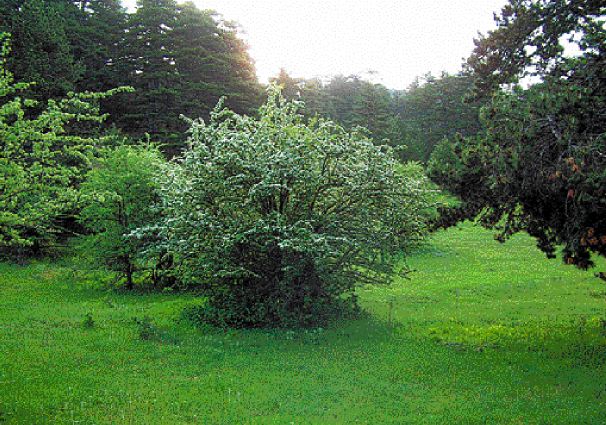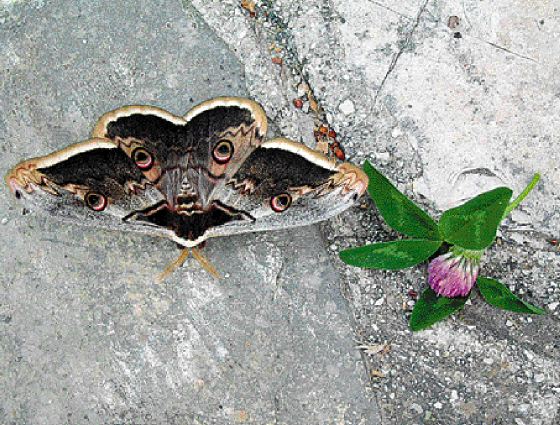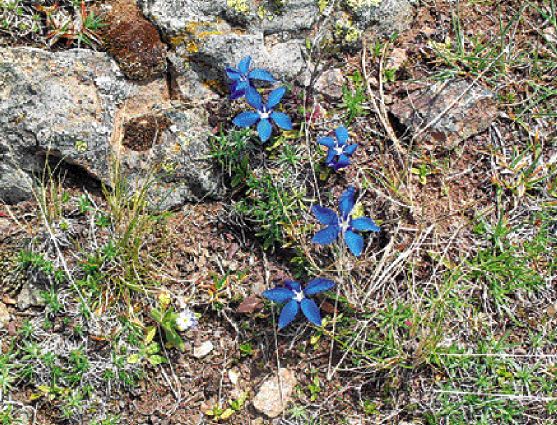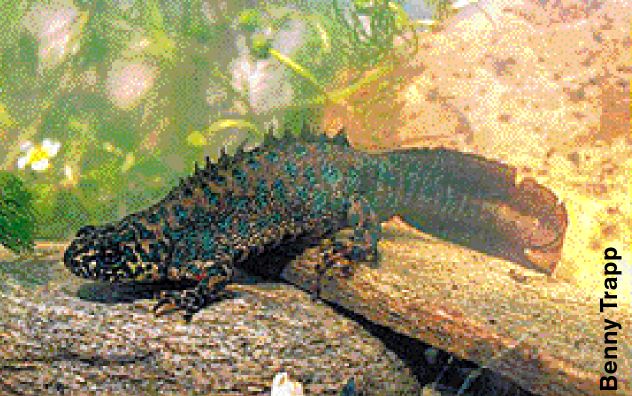 |
||
|
How Not to go to Grammos
|
||
|
By Penny Turner
Athens News |
||
In the morning I woke to hear nightingales shouting to be heard above the roar of the river in beautiful Eleftero, one of the Zagorohoria villages in Epiros. The kind people there told me that I would have to retrace my steps for a few kilometres to find the turn to Mount Grammos, which I had missed walking down the dark road from Konitsa the previous night. I had set off from Katerini three weeks before with the intention of getting to Grammos and exploring it. But, the nearer I got, the less I |
 The summit of 2,637m-high Mount Smolikas |
|
|
seemed to want to go there. For example, now, since I was already half way up Mount Smolikas, it seemed a good idea to climb the rest of it. After all, at 2,637 metres, it is the second highest mountain in Greece. Worth seeing. |
||
|
The people in Eleftero told me that there was a path near the summit of Smolikas that went to Grammos. So, I rationalised, it wasn't that I was delaying going to Grammos - honest! - more that I was killing two birds with one stone by visiting Smolikas... on my way to Grammos. There were fritillaries up there and loads of them, so George got a chance to help biodiversity by grazing selectively. Fritillaries, rare and interesting meadow flowers, are unpalatable to grazing animals but depend on grazing or mowing to keep |
 A May tree rooted in fairyland |
|
| their competitors (such as grasses) under control. George delicately used his lips to crop sweet grasses from between the bitter fritillaries and did his bit for conservation. I ignored the obvious track that led to Grammos and went back the way we had come. Why did I ignore the track to Grammos? I just don't want to talk about it. I just did. Ok? As night fell we reached Pades. Just next to the church, which has a most unusual bell tower, Tassos has a small hotel. He also had some paddocks for George. |
||
| I rented a room. In the morning I got up early, and found lots of huge moths just lying about. They had obviously all just metamorphosed, and most hadn't yet managed to fly anywhere, though I saw some bits of wing indicating that those that had tried to fly had immediately been eaten by bats. These are called the Great, or Giant, peacock moth and are the largest moth in Europe. "Why don't you go up to Drakolimni?" asked Tassos as I ate local honey and bread and drank fresh orange juice as well buckets of coffee. |
 The Great, or Giant, peacock moth is the largest of its kind in Europe |
|
| "We've got a Drakolimni on Smolikas, the one at Papingo is rubbish compared to ours. You can leave your stuff here." I hadn't realised there were Drakolimnes everywhere, but having failed to reach the famous one near Papingo because of the snow, I was keen to see what Smolikas had to offer by way of Dragon lakes. So I saddled up George and, free for once of all our heavy gear, he took off like a rocket. He gave a few exuberant bucks as we flew up the track and then settled into his stride. There can't be a more exhilarating way of getting up a mountainside. A couple of hours from the summit the path became too difficult for George, so I tethered him in alpine pastures, and set off on foot. It was pretty snowy and precipitous, the going was hard. I realised that I hadn't got time to make it to Drakolimni. |
||
But the consolation was to see gentians, those famous, gorgeous tiny, piercingly blue alpine flowers which I had never seen before, and also to see the crocuses and squill blooming as the snow that covered them melted. A bit lower I found the exquisite Alpine Snowbells. And lower down still, yellow tulips were scattered everywhere. A slow worm, a kind of lizard which is persecuted as if it were a snake just because it's got no legs, crossed our path and the fir trees were full of squirrels. When we got back to Pades, Tassos said: "Stay in your room for another night, free." |
 Having failed to make it to Drakolimni, we sought consolation in a wondrous view of blue alpine flowers |
|
| The next morning, where the giant peacock moths had been, were newly metamorphosed cream spot tigers instead. A toad in fairyland The Great, or Giant, peacock moth is the largest of its kind in Europe I made an early start, and by nightfall we were in fairyland. The Pindos mountains are high and chilly so many plants familiar from Northern climes grow there, and the folklore associated with them is Northern. |
||
|
|
 A most unusual belltower nestled in a plane tree |
|
I went to the source of the sound and found a great black toad, warty skin glistening, copper eyes glinting, hunting in the soft moss surrounding a pool. Milton sees the devil as "squat like a toad" and this animal was certainly satanic. Although he looked the part, he can't have actually been the loudly croaking king of the amphibians, because this kind of toad can't croak. Unless fairies use voice-over. In the morning I found a dragonfly larvae just changing into a dragonfly, and in the pool, apart from engaged couples of yellow-bellied toads, I saw some of their eggs attached to a twig and looking like a miniature bunch of grapes. |
||
| A huge new newt Having failed to make it to Drakolimni, we sought consolation in a wondrous view of blue alpine flowers I found what promised to be the most exciting wildlife of all near the village of Mavranei. While George grazed, I followed a little stream which was teeming with life. I saw a splendid example of the Epiros frog, which is what it says on the label - a frog unique to Epiros. I saw some smooth newts, I saw a dice snake hunting in one of the deeper pools. |
 A Triturus Karelinii |
|
| Then I saw something else. At first I thought they were salamander larvae. But they were different somehow. First they were bigger and beefier than normal. Second, their external gills were much redder. Third, they were extraordinarily sluggish and I was able to catch some with my hands and look at them. They had silvery pink bellies. I photographed them in the water, they posed obligingly. The minute I got home I emailed a friend who knows all about these things. "They'll be Triturus Karelinii, newly declared to be a species," he said. "They used to be thought to be a subspecies of the Crested Newt." "Wow oh wow!" I thought excitedly "I knew they were special! I've found babies of a really new newt!" I started bragging about my discovery far and wide. Another friend had recently found and photographed adults and larvae of this species. I emailed him too. He sent me photos of the larvae and the adult animal, which is really quite a beast. By this time I was in England and didn't have my photos to check against his, but I had a nasty feeling that my larvae and his weren't the same. So what could mine be? "If it is a salamander baby," he wrote, "it will have white spots where its legs join its body." "Of course it isn't a salamander," I thought. "I've seen hundreds of them and this definitely isn't one." But I checked it for white spots anyway. You guessed it. I was tempted to take the little bleeder to photoshop. Anyway, all that excitement and disappointment was yet to come. |
||
|
Now, as we made our way to Grevena, I was beset by a feeling not far from despair. We were leaving Grammos behind, once and for all, because I was running out of time; I had to get back. In one way I was relieved, now I really couldn't go there. But how I despised myself for not going when I could have done...as Bob Dylan says: |
 This slow worm is a kind of legless lizard persecuted just because it resembles a snake |
|
|
"Being afraid, " she said, "well, that's a terrible thing, because once you are afraid you can never be free again." |
||
|
(Posted 1 December 2006) HCS readers can view other excellent articles by this writer in the travel section of our extensive, permanent archives at the URL http://www.helleniccomserve.com./contents.html
All articles of Athens News appearing on HCS have been reprinted with permission. |
||
|
||
|
2000 © Hellenic Communication Service, L.L.C. All Rights Reserved.
http://www.HellenicComServe.com |
||

